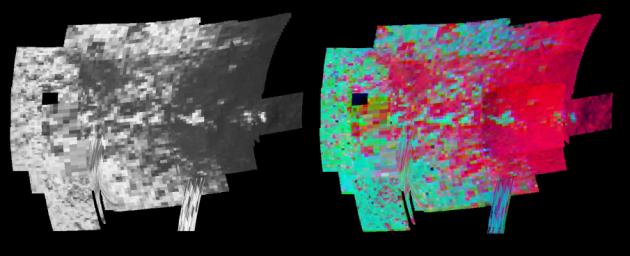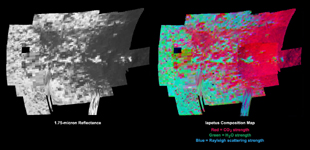
|
Tiny Grains on Iapetus
- Click the image above for a larger view
- Full-Res JPEG (1743 x 708) (147.9 kB)
- Full-Res TIFF (1743 x 708) (3.7 MB)
Caption:

Click on image for larger annotated version
Cassini made a close flyby of Saturn's moon Iapetus on Sept. 10, 2007, and the visual and infrared mapping spectrometer obtained these images showing surface composition and particle size.
The visual and infrared mapping spectrometer is like a digital camera, but instead of using three colors, it makes images in 352 colors, or wavelengths, from the ultraviolet to the near-infrared. The many wavelengths produce a continuous spectrum in each pixel, and these spectra measure how light is absorbed by different materials. By analyzing the absorptions expressed in each pixel, a map of the composition at each location on the moon can be constructed.
The left image in the figure shows the amount of reflected light at a wavelength of 1.75 microns in the infrared (green light seen by our eyes is 0.53 microns). The color image on the right shows the results of mapping for three components of Iapetus' surface: carbon dioxide that is trapped or adsorbed in the surface (red), water in the form of ice (green), and a newly-discovered effect due to trace amount of dark zsa~particles in the ice creating what scientists call Rayleigh scattering (blue). The Rayleigh scattering effect is the main reason why the Earth's sky appears blue.
The Rayleigh scattering effect on Iapetus provides evidence that tiny grains, less than the wavelength of visible light (less than 0.5 microns) have been embedded in the surface of Iapetus. The tiny grains must be well-separated for the Rayleigh effect to become prominent, so the abundance of particles must be less than about 2 percent. The Rayleigh scattering effect shows in all areas, although weakly in dark regions (the red carbon dioxide dominates the colorimage), and it appears stronger away from the equator. Investigating the trend from dark to bright areas, the Rayleigh effect changes with the amount of dark material in the ice, and becomes weaker as more dark material is added. This points to cleaner ice as one moves north or south from the equator and away from the dark leading side of the moon (toward the right in the image).
This provides additional evidence for an external source for the dark material coating Iapetus, and for ice transport away from the warm dark regions and equator to the cooler poles. The ice transport away from the equator increases the concentration of dark material there and reduces the Rayleigh effect. With the volatile transport from the dark warm regions, the strong carbon dioxide signature is a surprise because frozen carbon dioxide is more volatile than water ice. Therefore, the carbon dioxide must be trapped, making its presence stable in the warm equatorial region. The trapping mechanism is currently under study.
Background Info:
The Cassini-Huygens mission is a cooperative project of NASA, the European Space Agency and the Italian Space Agency. The Jet Propulsion Laboratory, a division of the California Institute of Technology in Pasadena, manages the mission for NASA's Science Mission Directorate, Washington, D.C. The Cassini orbiter was designed, developed and assembled at JPL. The Visual and Infrared Mapping Spectrometer team is based at the University of Arizona.
For more information about the Cassini-Huygens mission visit http://saturn.jpl.nasa.gov/home/index.cfm . The visual and infrared mapping spectrometer team homepage is at http://wwwvims.lpl.arizona.edu .
Cataloging Keywords:
| Name | Value | Additional Values |
|---|---|---|
| Target | Iapetus | |
| System | Saturn | |
| Target Type | Satellite | |
| Mission | Cassini-Huygens | |
| Instrument Host | Cassini Orbiter | |
| Host Type | Orbiter | |
| Instrument | Visual and Infrared Mapping Spectrometer (VIMS) | |
| Detector | ||
| Extra Keywords | Color, Infrared, Map, Ultraviolet, Water | |
| Acquisition Date | ||
| Release Date | 2007-10-09 | |
| Date in Caption | ||
| Image Credit | NASA/JPL/University of Arizona/USGS | |
| Source | photojournal.jpl.nasa.gov/catalog/PIA10010 | |
| Identifier | PIA10010 | |
